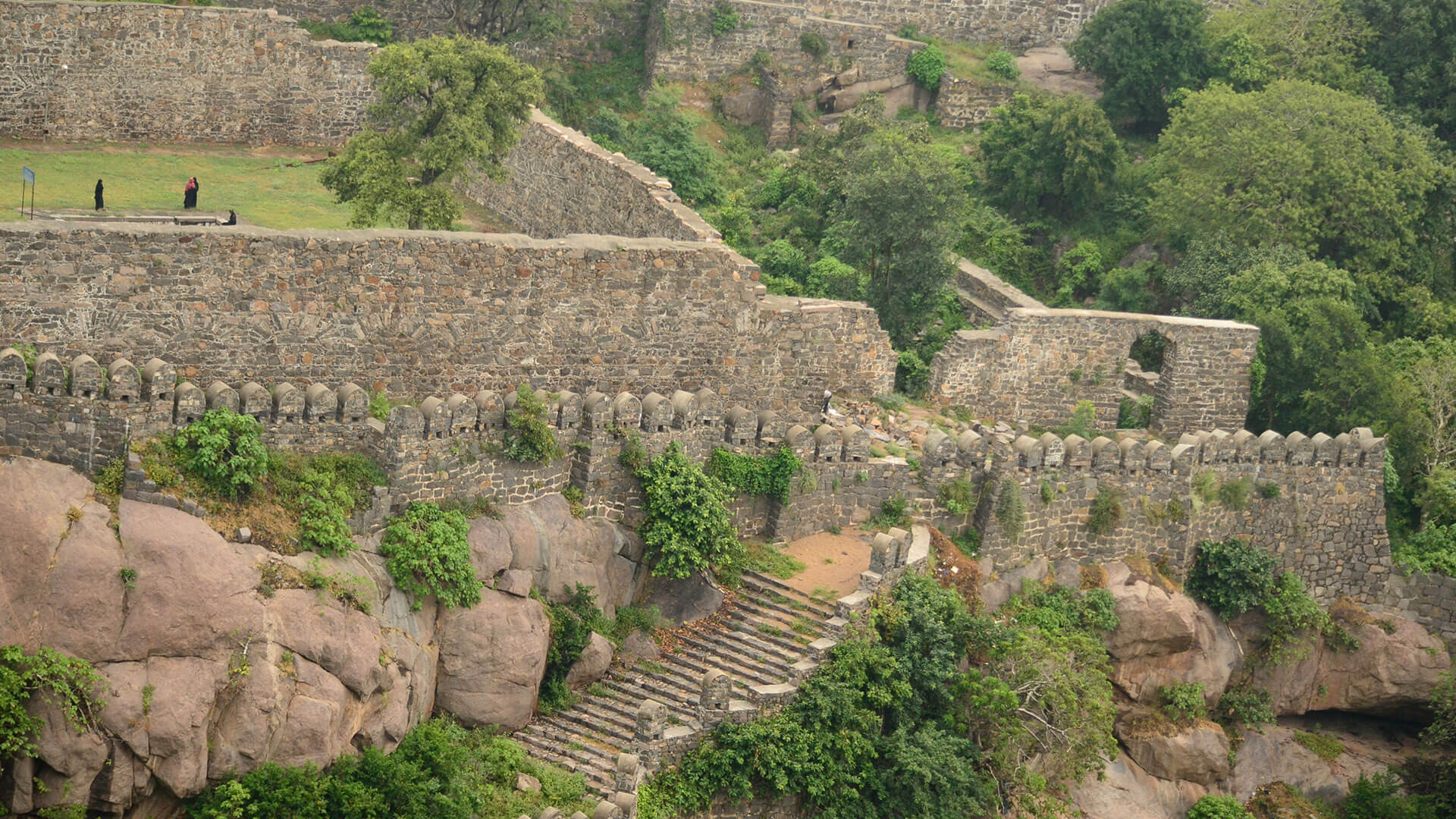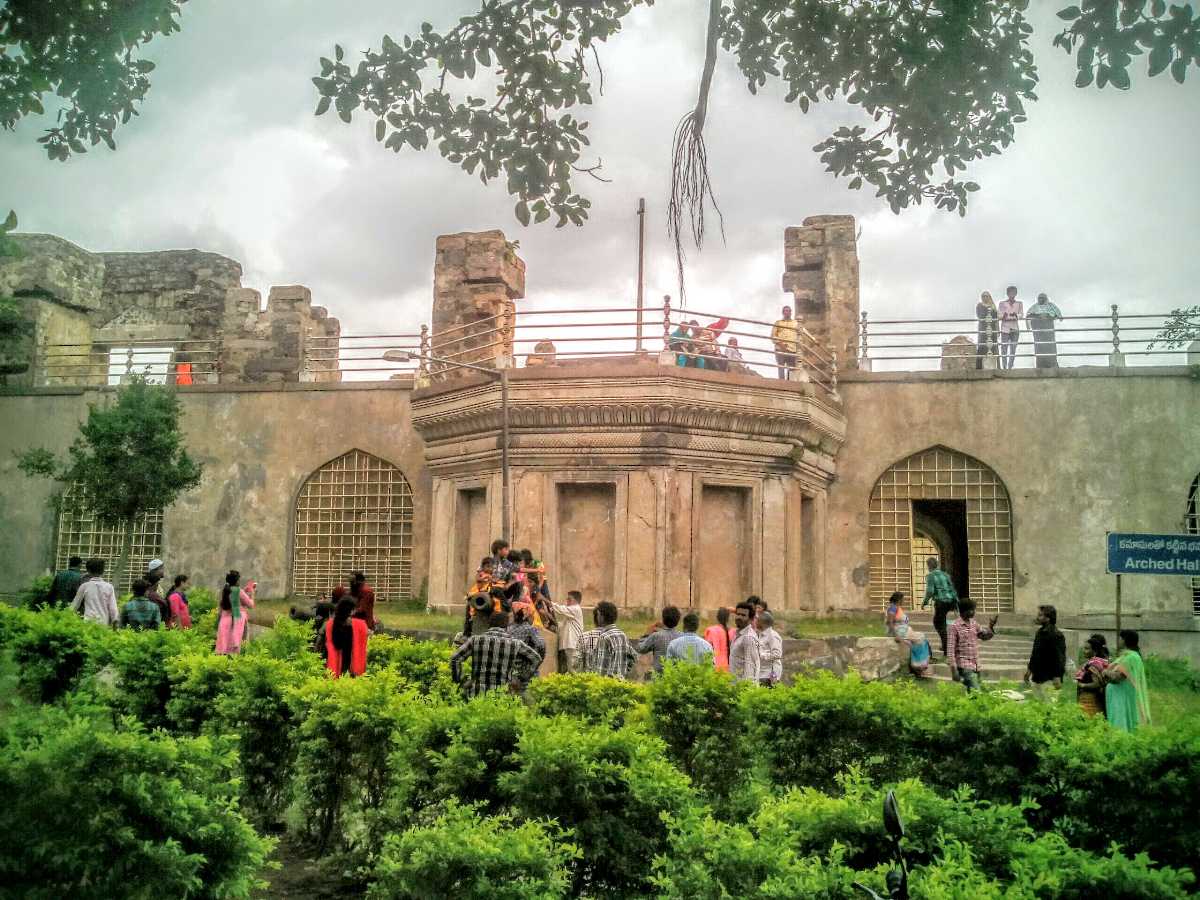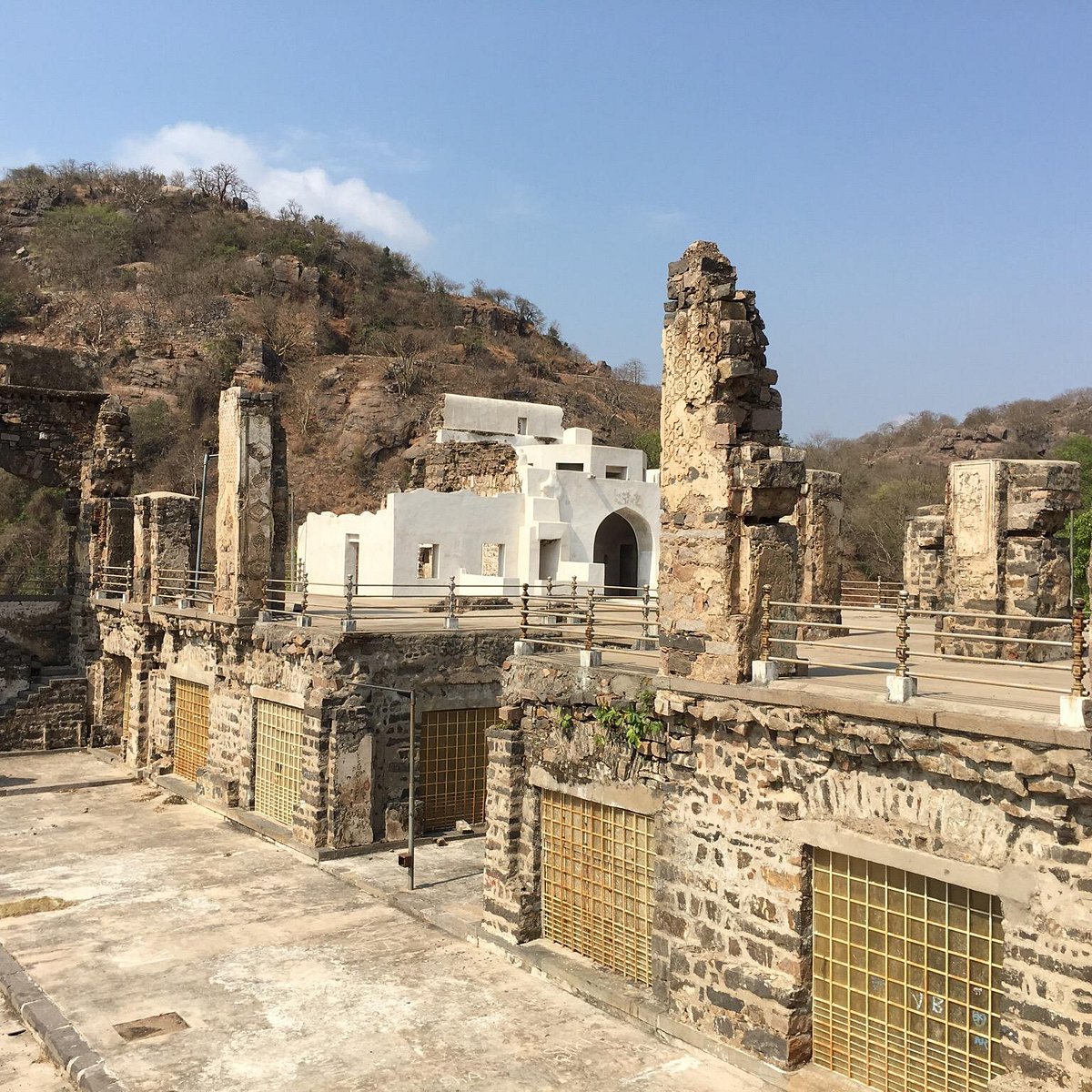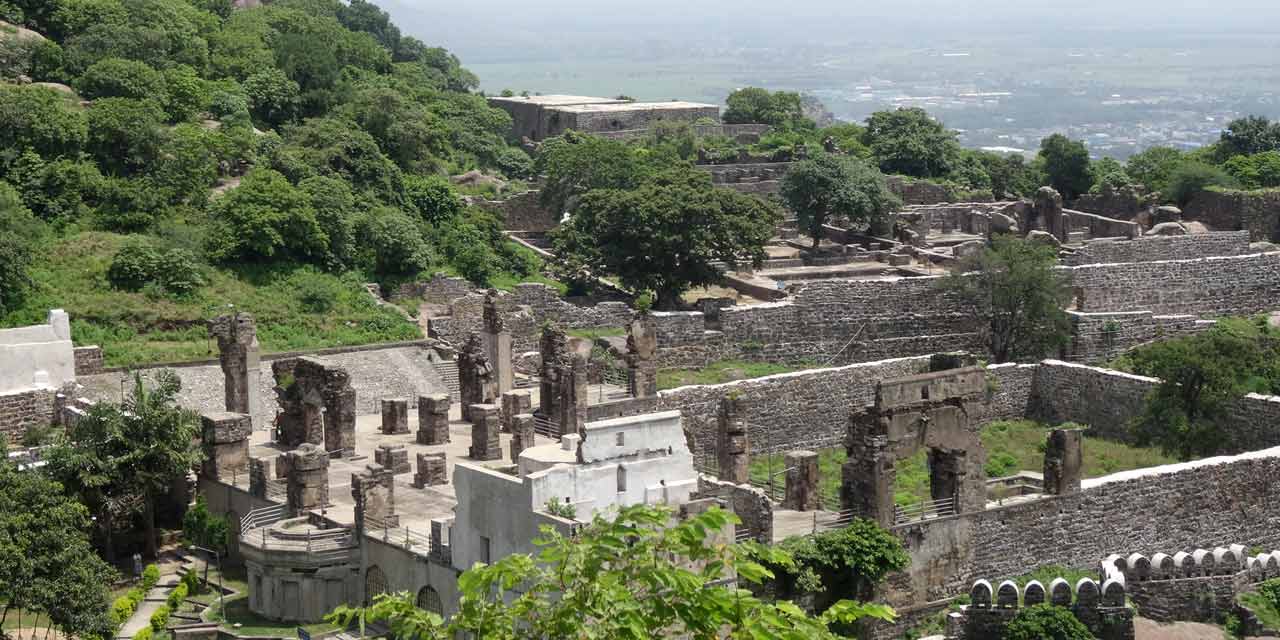Kondapalli Fort, also locally known as Kondapalli Kota, is located in the Krishna district, close to Vijayawada, the second largest city of Andhra Pradesh, India. The historic fort on the hill (Eastern Ghats) located to the west of the Kondapalli village was built by Prolaya Vema Reddy of Kondaveedu during the 14th century, initially as a pleasure place and a business centre, along with the Kondaveedu Fort in Guntur district. In later years, it was used as a military fortification and the British placed a strong garrison here. Apart from the fort, which is a major tourist attraction, another important artistic rural product of Kondapalli is the crafting of colourful toys, called the Kondapalli toys. A very light white wood is used to make the lively painted toys, including mythological figures, women and animals. This handicraft product has been given a Geographical Indication under the name “Kondapalli [Koyya] Bommalu” as protection given to a reputed product. The fort is located to the west of Vijayawada city in the main hill range known as Kondapalli in the Krishna district. The hill range, about 24 kilometres (15 mi) in length, extends between Nandigama and Vijayawada. The forest area in this hill range abounds in a type of lightwood known as ‘ponuku’ (Gyrocapus jacquini), which is used exclusively for the manufacture of the famous Kondpalli toys. The forest vegetation around Kondapalli fort and the nearby hills are also well known for medicinal plants and trees such as Phyllanthus amarus (Telugu local name “nela usiri” నేల ఉసిరిక చెట్టు), Phyllanthus, Andrographis paniculata (local name: “adavi mirapa” అడవి మిరప or “nelavemu” నేలవేము), Thedlapala (Wrightia tinctoria), Tephrosia purpurea, Albizia amara, Streulia urens and Chloroxylon swetenia.[9] The hill range is mainly made up of charnockites, with some pyroxene granulites, granites, khondalites, pyroxenites and dolerites. The Kondapalli Fort was built in 1360 by the Hindu kings of the Reddy dynasty of Kondaveedu. But, over the subsequent centuries, it was the theatre of several wars among many northern and southern Indian rulers and the British. In 1541, Kondapalii fort and the province were conquered by the Muhammadans. It was under occupation of the Bahmani Kingdom for some time, then with Gajapati rulers of Orissa followed by Krishnadevaraya of the Vijayanagara empire and it later fell into the hands of Muslim rulers of the Qutubshahi dynasty in the 16th century. Hamvira, the son of Gajapati Kapilendra Deva (1435–1466) of Orissa fought against the Reddys, scored a victory and occupied the whole of Kondaveedu territory by 1454. But in the historic struggle for power for the throne of Orissa, Hamvira had to fight his brother Purushottam, who had succeeded to the throne after their father’s death. He sought the help of the Bahmany Sultan in this war. He was successful in defeating his brother and occupied the throne of Orissa kingdom, in 1472. But in the bargain, he gave Kondapalli and Rajahmundry to the Bahmany Sultan. Subsequently, Purushottam defeated Hamvira in 1476 and occupied the throne of Orissa. But it is also said that in 1476, a revolution began at Kondapalli when there was famine in the Bahmany kingdom. The garrison of Kondapalli revolted and gave possession of the fort to “Hamer Oriya” or Hamvira. Purushottam, once he became the king, tried to get back Kondapalli and Rajahmundry from the Bahmany Sultan III. But when he held siege over Rajamundry, for some unknown reason he signed a peace treaty with the Sultan, which resulted in souring of relations between Bahmany and Vijayanagar rulers, which resulted in minor battles. But in 1481, after the death of Sultan Mahammad, the Bahmany kingdom was in disarray and taking advantage of this situation Purushottam fought with Mahmad Shah, the Sultan’s son, and took control of Rajahmundry and Kondapalli fort.Gajapati Purushottam Deva died in 1497 and was succeeded by his son Gajapati Prataprudra Deva. In 1509,Gajapati Prataprudra Deva started a war against Krishnadevaraya of Vijayanagar Empire, but Gajapati had to retreat to the north to defend an attack by Sultan Allauddin Hussan Shah of Bengal. The consequence was that Krishnadevaraya had an easy victory over Kondapalli, which he occupied in June 1515. In the last war fought in 1519, Krishnadevaraya once again defeated the Orissa ruler. Since the Kondaveedu fortress was very strong, after three months siege of the fort, Krishnadevaraya had to personally direct the operations to get control of the fort. Following this war, Krishnadevaraya married Gajapati Prataprudra Deva’s daughter,Kalinga Kumari Jaganmohini. A treaty was also signed for restoring all land up to the southern boundary of the Krishna River to Orissa, which included Kondapalli. But after the treaty with Vijayanagara emperor, between 1519 and 1525,Gajapati Prataprudra Deva had to defend his territory against invasion by Sultan Quli Qutab, the Sultan of Golkonda. But in the final assault, in 1531, Kondapalli came under the rule of Sultan of Golkonda. The war with Golkonda Sultans was continued by Govinda Bidyadhar, the new ruler of Orissa Kingdom who had succeeded Gajapati Prataprudra Deva (who died in 1533) but ended finally with a treaty with the Sultan. The area came under Mughal rule in the 17th century. After the disintegration of the Mughal Empire in early 18th century, Nizam ul-Mulk, what later became the Nizam of Hyderabad declared independence and took the area under its control. In late 18th century the area was still under the Nizam’s rule, a treaty of alliance was signed between Nizam Ali and the British East India Company recognizing the control of the British over the territory. This treaty was initially signed on November 12, 1766 under which the company in return for the grant of the territory agreed to garrison troops in the fort for Nizam’s aid at an annual cost of 90,000 pounds. It is also stated that in 1766 the British, under General Caillaud, stormed the fort and took control of it. A second treaty was signed on March 1, 1768, under which the Nizam recognized the grant provided to the British by Mughal ruler Shah Alam. But, as a gesture of friendship, the British (then the East India Company) agreed to pay an allowance of 50,000 pounds to the Nizam. However, in 1823, the East India Company rested total control of the Sarcars under an outright purchase from the Nizam. In the initial years, the fort was used as a business center but after the British took over the fort in 1766 it was converted into a military training base. The fort, which has a very picturesque sight, has three successive entry gates. The main entrance gate is called the ‘Dargha Darwaja’ built with single block of granite. It is 12 feet (3.7 m) wide and 15 feet (4.6 m) high. Its name is derived from the tomb or dargha of Gulab Shah, who was killed in battle here. Besides Darhgha darwaza, another entrance gate called the Golconda darwaza is located on the other end of the hill, which leads to Jaggaiahpet village. The fortified wall has towers and battlements. At the far end of the fort there is the Tanisha Mahal or Palace, perched on a crest between two hills. The palace had many chambers on the ground floor and a huge hall on the upper floor. In addition, there are several buildings still standing in the fort, which are ruins. There is deep reservoir near the palace, which is sourced by a spring. The water in the reservoir is said to be very cold and to cause fever. There are numerous other water tanks in the fort area, which go dry during the summer months. An old granary now in ruins, beyond the reservoir, is inhabited by bats. An English barrack is still standing in the fort area, which has eight large rooms, apart from a house in an annex. An English cemetery is also seen in the fort. The Fort is connected by road from Ibrahimpatnam and Kondapalli villages. It is 21 kilometres (13 mi) by road from Vijayawada on National Highway 221. Hyderabad–Vijayawada railway line passes through Kondapalli. To reach the fort by foot, there is way from Kondapalli village. To reach it by any vehicle, there is road way from Jupudi village, on National Highway 9 (India). Vijayawada city, as the largest commercial centre of Krishna district, is connected by railway lines to Delhi, Calcutta, Madras, Hubli, Gudivada and Machilipatnam. The airport at Gannavaram is about 16 kilometres (9.9 mi) away from Vijayawada. A minor sea port is at Machilipatnam. From the Kondapalli village, the fort precincts are approached through a 1 kilometre (0.62 mi) trek through the forest.
Gallery



